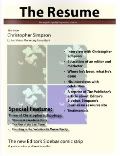User-created content: great for users, but hell on advertisers
The following is a reprint of the Ad Nauseam column which appeared in the October 14, 2008 edition of the Metaverse Messenger
A TV commercial can cost hundreds of thousands, sometimes even millions of dollars. The reason is two-fold: not only are vast numbers of people watching the shows (and hence the ads), but the production costs of TV shows put their creation well beyond the means of the average person. Even with a few hundred channels, there is still a limited number of programs because it takes big corporations and big bucks to make even the cheapest reality show. So what would happen if a technology came along that allowed people to create their own shows for free?
The answer is simple: ad revenue would disappear. With an almost endless number of new shows, strategic ad placement would become impossible and the worth of an advertising spot would plummet. Shows with ads would lose audience to shows without. Ads may be placed on the service distributing the shows, but they would have little relevance and be easily ignored. In short, advertisers would essentially ignore the platform and the only way it could make money would be to charge for its use.
As most of you probably realize, this situation is not hypothetical — it’s YouTube. And while nobody can doubt the success of the site in terms of users, its earning power has remained stubbornly untapped. A 2006 article in the Bivings Report by Erin Teeling (“YouTube: Show me the money!”) pointed out that even though the video-sharing service was still in its early days, it had already racked up some impressive statistics: 6.1 million videos, a total of 9,305 people-years spent watching them, roughly 500,000 profiles, and a ranking of 8th most popular site in the US. But these bright and shining figures merely served to cast a darker revenue shadow. “Underneath these amazing user stats,” said Teeling, “there are financial problems. It seems that YouTube and other sites like it that depend on free, user-generated content, have yet to figure out a way to turn site traffic into profit.”
Along with the difficulty of trying to monetize user-created content, Teeling’s 2006 article lists a number of other YouTube drawbacks that sound eerily similar to those facing Second Life, including copyright infringement and the risk of a brand’s association with “offensive or questionable” content.
Google bought YouTube in 2006, but as recently as this past June the corporation had to admit that its famous Midas touch wasn’t working. Sarah Arnott’s article for the UK’s Independent (“Google admits it still can’t make money from YouTube”) quotes Eric Schmidt, Google’s chairman and chief executive, as saying that while there was obviously money to be made from the site, they still hadn’t figured out how to do it.
In only a few months, however, the situation appears to have changed. This week Google unveiled a new advertising plan which shows every chance of succeeding. Anders Bylund of The Motley Fool, a major investment online magazine, explains that since “six of the ten most-watched videos of all time are straight music videos,” the plan is to incorporate “unobtrusive but easily accessible links” to the online stores selling the actual songs. This will give viewers the opportunity to buy their favorite tunes instead of always having to go to YouTube. And as Bylund points out, “this is just the first example of YouTube growing into a full-fledged e-business platform.” Corporations whose content appears on the site can “claim ownership of the user-uploaded videos they used to want removed and add some cash-generating shopping links to them.”
But while we may look for guidance to Google’s YouTube solution (while keeping in mind that it has not yet proven successful), we cannot transfer it directly into Second Life. YouTube content sits on a neutral background easily accessible to advertisers: Second Life content sits on a background owned by the creators of the content. While real-world companies may be able to make deals with a few Second Life content providers to give space for related advertisements, it’s hardly a universal remedy. One example would be Coca-Cola renaming the popular in-world blues venue “The Junkyard Blues” to “Nestea Live Music Stage at Junkyard Blues.” And while we applaud the idea behind the tactic, it is still little more than a sponsorship package. Coca-Cola would be naïve to believe that residents are going to start drinking a particular beverage merely because of a banner hanging over a stage — especially a beverage that has no traditional connection to the music. (Now if the Junkyard Blues stage were to be sponsored by Johnny Walker or Southern Comfort the results might be more positive.)
The Google approach to YouTube provides a new service that will both improve the YouTube experience and earn ad revenue. The Coca-Cola approach to Second Life, on the other hand, provides nothing new and brings little, if any improvement. But more important is the involvement indicated by these two approaches. The new Google strategy has all the earmarks of something from the mind of a dedicated YouTube user, while the Coca-Cola strategy feels more like a pretty good idea cooked up in a board room among people who have visited Second Life only long enough to “get a feel” for it.
The key point is simple. Those who are truly interested in breaking into the virtual world are going to have to forego their corporate approaches and learn to love the world for its own sake. At that point it’s quite likely that the key to serious ad revenue or marketing success will suggest itself: first and foremost as an enhancement to the experience, and secondly as a means to make boat-loads of money.






0 comments:
Post a Comment